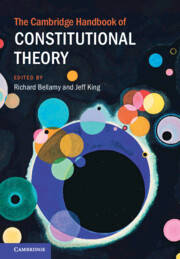Book contents
- The Cambridge Handbook of Constitutional Theory
- The Cambridge Handbook of Constitutional Theory
- Copyright page
- Contents
- Figures
- Contributors
- Frontispiece
- Preface and Acknowledgements
- 1 Introduction
- Part I Values
- Part II Modalities
- 10 Impartiality
- 11 Constitutional Legitimacy
- 12 Sovereignty
- 13 Constituent Power
- 14 Representation
- 15 Deliberation
- 16 Opposition
- 17 The Separation of Powers
- 18 The Rule of Law
- 19 Constitutional Conventions
- 20 Secularism
- 21 Constitutional Review
- 22 Constitutional Interpretation
- 23 Proportionality
- 24 Civil Disobedience
- 25 Constitutional Entrenchment
- 26 Emergency Powers
- 27 Regulation
- 28 Cost–Benefit Analysis
- 29 Revolution
- Part III Institutions
- Part IV Challenges for Constitutional Democracy
- Bibliography
- Index
- References
13 - Constituent Power
from Part II - Modalities
Published online by Cambridge University Press: 27 March 2025
- The Cambridge Handbook of Constitutional Theory
- The Cambridge Handbook of Constitutional Theory
- Copyright page
- Contents
- Figures
- Contributors
- Frontispiece
- Preface and Acknowledgements
- 1 Introduction
- Part I Values
- Part II Modalities
- 10 Impartiality
- 11 Constitutional Legitimacy
- 12 Sovereignty
- 13 Constituent Power
- 14 Representation
- 15 Deliberation
- 16 Opposition
- 17 The Separation of Powers
- 18 The Rule of Law
- 19 Constitutional Conventions
- 20 Secularism
- 21 Constitutional Review
- 22 Constitutional Interpretation
- 23 Proportionality
- 24 Civil Disobedience
- 25 Constitutional Entrenchment
- 26 Emergency Powers
- 27 Regulation
- 28 Cost–Benefit Analysis
- 29 Revolution
- Part III Institutions
- Part IV Challenges for Constitutional Democracy
- Bibliography
- Index
- References
Summary
The concept of constituent power emerges alongside that of the modern documentary constitution. It expresses the conviction that the authority of the constitution rests on its having been drafted in the name of ‘the people’ who, through an exercise of their constitution-making power, are the authors of that constitution. Conceiving the constitution as an expression of collective self-government, constituent power is therefore closely associated with the concept of popular sovereignty. This chapter examines how constituent power emerged in modern thought, explains its original meaning, sketches its subsequent evolution in thought, and evaluates the role it continues to play in contemporary constitutional discourse.
- Type
- Chapter
- Information
- The Cambridge Handbook of Constitutional Theory , pp. 208 - 224Publisher: Cambridge University PressPrint publication year: 2025

